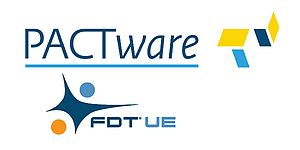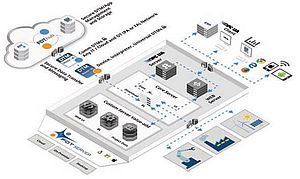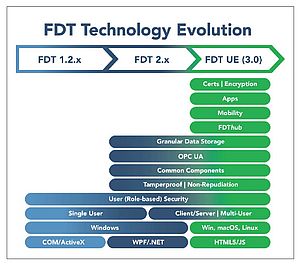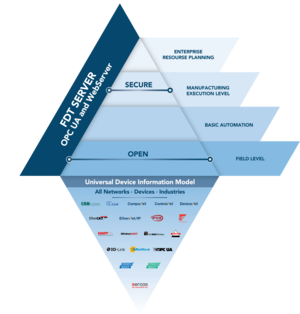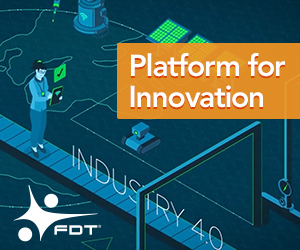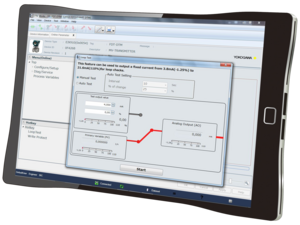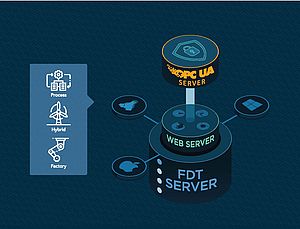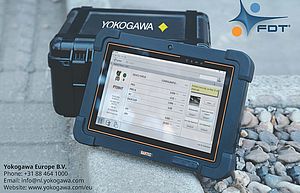Can you tell us more about the FDT 3.0 IIoT ecosystem? How can this help optimize next generation automation solutions?
G. Schulz: The IIoT ecosystem designation comes because in this architecture we have now placed a server. The FDT server is highly scalable. It fits all the classic IoT requirements and capabilities, and our ecosystem continues to expand. We are, in one sense protocol agnostic. In the larger sense, what this part of the ecosystem means to the end user is that they can remain essentially oblivious to what network of particular devices on when they’re talking with, it doesn’t matter how many layers deep it is. They are able to directly access that device. And then another part of the ecosystem with FDT 3.0 is all the toolkits and capabilities that we make available for developers, so that basically, they can go to market much quicker with their FDT enabled products. In terms of the optimization of next generation automation solutions, in the fact that you can access all of the information from FDT, wherever you are, the mobility aspect of it, in consideration of the type of solutions that can be offered with, end users can do optimization around these considerations. For instance, some more senior engineer or senior technician can remotely access information to help a junior person to troubleshoot a problem or to commission a line without having to physically travel into the facility. In the context of COVID-19, it is a pretty important deal.
What kind of contribution does the FDT group brings to smart manufacturing, and mobility?
G. Schulz: The FDT group is a standards organization. What we do is providing the underlying capabilities for smart manufacturing and mobility. For example, in the era of smart manufacturing, the world is pretty much standardized on OPC UA, in terms of how we want to access data from different systems to be able to leverage that data elsewhere in the enterprise. The new FDT server architecture includes an OPC UA server. The data is available across the enterprise because of the FDT standard and is now freely accessible for other uses within that enterprise through OPC UA. For example, you might have a request where a production manager asked for a dashboard to be put together to monitor a new production line. Well, that is trivial if you can immediately get all that information through OPC UA without having to reprogram the PLC or intervene with the DCS because the FDT standard sits side by side at a peer level with the PLC and DCs so it can offer up all of that information to elsewhere in the enterprise without disrupting the control environment. The same is true for mobility: the FDT server, or the user interface can now be accessed through any browser.
A few weeks ago, the ODVA announced CIP Security enhancements to support resourceconstrained Ethernet/IP Devices. What does this bring to the FDT 3.0 FITS platform?
G. Schulz: It brings more security to the overall solution, obviously. First, I have to compliment the ODVA, I think they are showing the industry what is necessary to develop and enhance a secure communications protocol. We do not have any parallels for that in the industry. CIP security is so important for our industry in general, for us as a standards organization. This means that when we are connecting using these protocols, then we can be ensured of a more completely secure solution. Without that you can have a network that is unsecured that is talking to a highly secured environment like the FDT server. And that is not optimal from a security perspective. So as the ODVA organization continues to ratchet up the security that they make available through CIP security, this is only going to benefit the industry and FDT enabled solutions as a result.
In this critical time of the pandemic, how can your solutions give a hand to companies working with reduced staff or remotely? For example, how can the FITS standard can help them?
G. Schulz: The new FDT server features an internal web browser, so that any web browser can attach to it. We have enhanced the user interface that is aware of the dimensions of the screen, whether there is a physical keyboard or touchscreen. It has a responsive UI. “Secondly, a remote solution is great” a remote solution is great. But if you do not wrap that tightly with the secure remote solution, then it is not really a workable feature in a standard like ours. We have spent a great deal of time to look at the underlying architecture related to security, so that when people do work remotely with our new standard, whether that is because of reduced staff, whether it is because of some domain expertise, they can connect securely to that remote server. When you are doing online banking, we are all conditioned now to look at the URL bar and make sure that I am really talking to the server I think I am talking to, which is my bank, and it is not somebody fishing and trying to get me to give up my credentials on some other site. I think we are familiar with that. Certainly, the FDT standard has that capability built in. But there are also cases where the IT or OT department when these people work remotely, may not want to allow them to use just any device to access that remote server, but may require that it be an authorized device from the company, or one that has been secured by the company. Therefore, they can turn on an additional feature in the FDT server that will ensure that only authorized clients can even connect to the server. If you were under those circumstances, pick up your personal smartphone, even though you know the address of that server, when you try to connect it will simply refuse the connection. So, you would not even get to the point of being able to use your login credentials. It would be more like the server is not even there, is not going to talk with you at all, because you do not have an authorized client device. Thus, if we layer these kinds of features into the standard depending on the security profiles that the company wishes to maintain, they can turn on these enhanced features to ratchet up that security. Once you are in a confident, secure environment, you can log into that server. And you can do virtually anything you could do if you were standing physically in that same facility, so you can look at the health of your network, you can look at the health of your devices, you can get real time data from your devices, you can browse the manuals for the devices, you can set parameters on them.
In your opinion, what changes will bring 5G in industrial communication? What benefits will it bring to the factory? How can the FDT group can benefit from 5G?
G. Schulz: 5G, at its core, brings more of what the promise of IoT is, which is just smart devices connected with physical networks wired up to some controller, but also devices that have no wire at all and are just sitting on a simple Wi Fi type network, for example, or Bluetooth network with its limited capabilities. You particularly can see these examples when you start thinking about AI applications, distributed DCs applications, or even in a classic industrial control environment where you wish to add additional sensing, additional monitoring capabilities to some process, instead of having to use hardware to do such. These devices can now have a 5G connection. And I think the real advantage here is simply the bandwidth and the additional security that 5G brings. The other advantage of 5G is that architecturally you can go up to the cloud with that device instead of necessarily having to go directly to a PLC or DCs. From a FDT perspective, we immediately benefit from 5G because it is largely transparent to our standard. All the 5G capabilities can immediately be leveraged through the FDT standard. It does not matter what is the underlying protocol of that remote devices. Because we support all those protocols. Thus, it will be just a natural extension to the FDT standard.
Do you have anything more to say to our readers?
G. Schulz: The thing that we continue to see as one of the highest levels of interest, beyond just the mobility capabilities, is the whole built-in OPC UA capabilities. Since we already have direct lines of communications to all the devices, and we can see the health of all the underlying networks, it really is a powerful addition when you bring the FDT server into a control environment. Suddenly, all that working used to be done to get the information routed through the PLC up to the ERP or some other application now becomes almost a trivial exercise, because you can attach to the FDT server if you have the right credentials, and you can browse the data structure of the facility. You do not even have to necessarily know that particular device name. You can use the OPC UA capabilities, just browse, find the device, find what information is available to get that information integrated into your application. Yes, I think that this has driven a lot of conversations for end users about the capabilities of the new FDT standard. I think everybody is very comfortable with all the things we continue to do because of our legacy of configuration, diagnostics. The OPC UA capabilities are really an eye opener for people.





